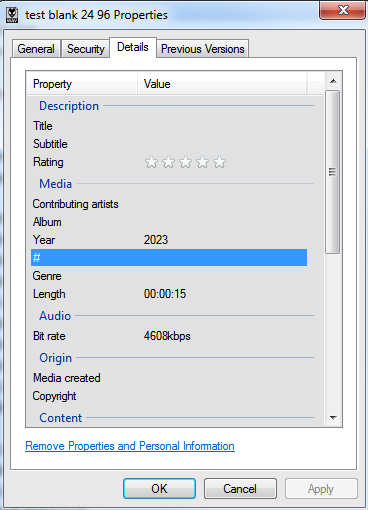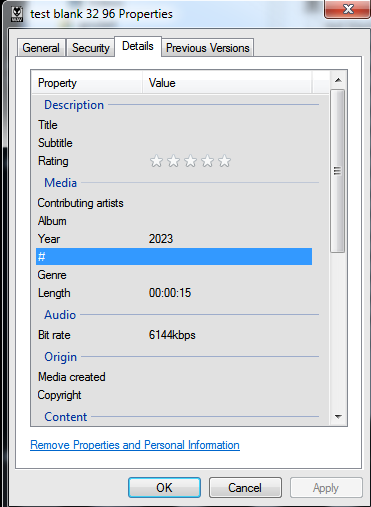Hi - I have a question not directly linked to my Denon equipment but does involve it.
I understand sample & bit rates like 44100 kHz @ 16 bit (CD) plus 96000 kHz @ 24 bit (my SC6000) & others that I use but can not find what the equivalent is for each of these in general against other sample rates like kbps. Is there a chart that shows all the equivalents, i.e. like for like.
As when you purchase downloads from different sites they are often listed in different sample rate formats.
Although a conversion chart would be good one reason I would like to know is I am sure most of you are aware of Mixcloud, they say for music it needs to be at 320 kbps, but how does that compare to say, 4100 kHz @ 16 bit or 96 kHz @ 24 bit.
One thing that I found on the internet says 320 kbps is the same as 44100 kHz but another says is not as good as 44100 kHz @ 16 bit CD so any ideas please.
Keith
A 320kbps MP3 is not as high quality as a 16bit/44.1kHz .wav/.aiff file (which will generally be plenty sufficient for most situations  )
)
2 Likes
The bitrate of a CD (44100k 16 bit) is 1141Kbps but that’s uncompressed, so even if there’s silence in the track it still takes up space, making the files large.
Compressed (lossy) formats such as MP3 save space by removing data - typically parts of the audio that are hidden behind other louder parts, which you wouldn’t hear anyway.
IMO a 320k MP3 would sound perfectly acceptable to the majority of adults playing it on a commonplace audio system. An MP3 can still be 44100 16 bit. The 320k part is the bitrate for the compression.
2 Likes
Frequency sampling rate and bitrate are totally different issues, unless you’re talking completely uncompressed lossless formats like WAV & AIFF when they become related and constant. You can have a 100kbps 24bit/96khz track if you don’t mind lossy codecs. Prime is not currently capable of fully rendering lossless 16/44.1 tracks, which come out as roughly equivalent to an MP3’s measurements of frequency bandwidth and distortion added, so I wouldn’t worry too much about it if you’re choosing Prime for reasons other than sound quality.
1 Like
A 320kbps MP3 is not as high quality as a 16bit/44.1kHz .wav/.aiff file (which will generally be plenty sufficient for most situations
Hi KrisONeil - Thanks for taking the time to reply and the info.
Keith
1 Like
Hi PKtheDJ
Thanks for the info and taking time to reply.
Keith
WAV & AIFF when they become related and constant.
Hi Reticuli - Thanks for thanking the time to respond, yes my use and understanding is of sample rates are CDs 44100 kHz @ 16 bit, but my own digital copies I make at 192.000 kHz @ 24 bit are wav uncompressed but scaled down to 96,000kHz @ 24 wav uncompressed bit for the media players I have. That’s why other formats confuse me as only know these.
Keith
Copies of what though? If you’re copying CDs, the bit rate will only ever be as good as the source material. So if you’re copying a CD quality track and upsampling it to 192 kHz, it will still only be a CD quality recording, but take up much more space. Upsampling doesn’t add any information that isn’t already there. The recording won’t be better, just larger.
Uncompressed CD quality is more than sufficient for playback and anything else is really overkill at the expense of more space being used, IMO. If you really want to have the high quality recordings, you can still go CD quality but compress it a lossless format such as FLAC.
1 Like
I won’t deny that upsampling can occasionally sometimes do interesting stuff through interpolation like on the Burmester stuff or the old X1700, but usually doesn’t, and downsampling rather than just keeping it in the original sample rate or just recording in the lower sample rate you are eventually going to use tends to produce more faithful results, anyway. You never get more advantage intentionally recording at a higher rate and downsampling. Even doing non-realtime downsampling in post is not perfect, and there are wildly differing ways of doing it. We used to think there was some advantage to doing double the rate for audio, like 88.2 and bumping it down to one half, like 44.1, but that’s been since debunked. Unlike video telecine, doing that with audio causes more issues than helps.
https://src.infinitewave.ca/
I also agree that Redbook CD format is mostly sufficient even if it’s not quite the optimal rate from a “Perfect Sound Forever” standpoint of giving great sound in practice from any reasonable hardware engineered, and since that’s what 99% of tracks are in, anyway, people should probably be worrying about that more than anything else – for the format, for the gear rates, etc. I mean, technically, the ear/brain system is limited to about 20bit/48khz assuming reasonable DAC anti-aliasing filter design and some other stuff, and higher bit depth is certainly nice for the processing domain side if you need to do processing, but once you get to a physical output, you can’t advantageously hear anything more than that, and output content substantially into the ultrasonic range, whether actually part of the original music or not, is going to degrade many analog components’ real performance that have to deal with it along the chain. You might hear an effect, but it’s of increased downstream analog component distortion.
However, then there’s the question when using 48khz to begin with and sticking to it how much advantage there is from not subjecting it to sample rate conversion and how much is a little breathing room for DAC anti-aliasing filter variations. It’s probably a tossup or a little of both. I got to hear a significant artist’s original 48khz studio master once, which I believe was recorded at 16 bit depth, though it was processed in float, and I was flabbergasted at how much better it sounded than the 44.1khz Redbook release version, but part of that can, again, easily be chalked up to the fact it underwent SRC rather than being natively recorded & produced at 44.1khz and the rest was the result of using a consumer device rather than something state-of-the-art to do my listening.
Hi – Airvince / Reticuli
Sorry for any confusion, my original question was to see if there was a comparison list / chart for say all the different download formats I purchase compared to say 44,100 kHz @ 16 bit or 192,000 kHz @24 bit and so on… As I could never tell the quality of a download I purchase up against digital copies I make myself i.e. A direct comparison to my own. I have never upscaled any format as I know you can’t make it sound any better by doing so plus from what I have read doing a upscale may just cause problems anyway.
My digital copies are made from vinyl at 192,000 kHz @ 24 bit Wav uncompressed on a reasonable system and they sound no different to playing the record direct on my Hi-Fi which is fairy good but rather old now unfortunately.
But I do scale them down (re-save) at 96,000kHz @ 24 bit for my media players, the players do play the 192,000 kHz file but the output of the players is only 96,000 kHz so no point, plus takes up a bit less memory but also they load quicker too.
Regards
Keith
I just calculated this. I also tested it for WAV 32 bit float, too. By the way, very large files are an issue, which is why something like Sony Wave64 was developed. Wondering now if Prime/Engine supports Wave64, actually…

Hi Reticuli
Thanks that is very useful information.
Keith
1 Like


